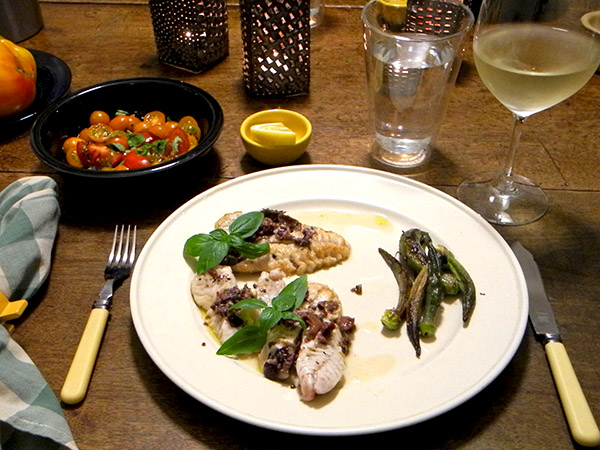Note to self: The fish was astoundingly good, in both taste and texture, and the vegetables, which actually happened to be what I had on hand, excellent accompaniments.
There really are other fish in the sea. And some of them are scrumptious.
Please do not tell anyone about the ‘sea robin’, or ‘gurnard’, who might not discover this post on their own; its impecunious devotees might become very angry with me if the news of its virtues were broadcast too widely. This delicious, yet widely and unfairly disparaged fish, is incredibly tasty, very inexpensive, and, in our experience on this occasion at least, without bones. Found in abundance in seas from Southern New England and New York to Cape Hatteras, the species is among the least expensive, and apparently least endangered, of any of those harvested from our local waters; I can attest to their numbers anecdotally, having actually gone out into local coastal waters to pull in some cousins of theirs who are generally regarded as a far more desirable catch.
Now I can also attest to their toothsomeness.
The price of Sea Robin reflects its demand (pretty weak) and its supply (a seeming abundance). $5.45 was enough to bring home the six fillets, which weighed a total of about .82 pounds, an amount which worked out perfectly as portion for two.
I found almost no information on their cooking (even Mark Bittman is silent on this species, in his book and anywhere else on line), but since our Sea Robin is related to the Mediterranean Rascasse, I searched under that name and came up with this recipe, for Rascasse à la tapenade. Since deciding to use it, I’ve come across a couple more, and I expect to take advantage of my new, small inspirational ‘index card’ recipe bounty following future visits to my local fish mongers.
- six small fillets of sea robin, aka ‘gurnard’, from P.E. & D.D. Seafood, rinsed, pat dry, then placed in a pan of sizzling olive oil and sautéed over medium-high heat for barely 2 minutes on each side, transferred to two plates, a little lemon squeezed on top and a bit of a tapenade sauce* spread over the fillets, which were garnished with fresh basil off of a plant from Full Bloom Market Garden in Whately, Massachusetts, purchased at Whole Foods and currently happy in one of our south windows
- a few purple okra from Lani’s Farm, remaining from the batch we enjoyed yesterday, again sautéed in olive oil with crushed dried chiles in an iron pan over a high flame, seasoned with salt and pepper
- a salad of tiny golden cherry tomatoes from Eckerton Hill Farm and two very ripe Maine cherry ‘cocktail’ tomatoes from Whole Foods, dressed with a good olive oil, salt. pepper, a few drops of balsamic vinegar, and chopped fresh oregano from Lani’s Farm
- the wine was a Spanish white, Naia D.O. Rueda 2014, from Verdejo old vines
- the music was Giovanni Paisiello’s 1782 ‘Il Barbiere di Siviglia‘ (one of the composer’s 94 operas), conducted by Adam Fisher
* see this recipe for details (in which I incorporated Gaeta olives, salted capers, and one salted anchovy, all from Buon Italia, and some chopped fresh thyme from Keith’s Farm)
